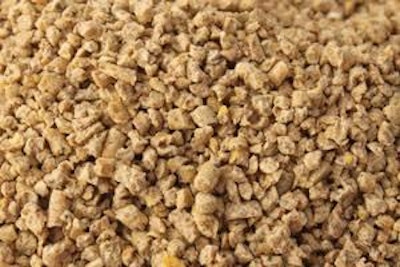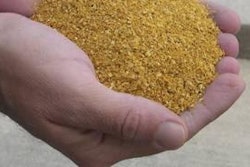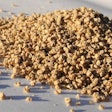
Presentations at the 2010 Poultry Science Association meeting in Denver, Colo., documented advances and trends in feeding U.S. flocks producing table eggs. Interpretive reviews of significant papers are provided dealing with the benefits of additives, supplements and new ingredients.
DDGS
With the national trend towards incorporation of DDGS in diets for egg-producing flocks, there has been extensive research on appropriate levels of incorporation and the effect of enzymes to enhance nutrient value. With the escalation in cost of corn attributed in large measure to diversion of up to one-third of the U.S. crop into ethanol, DDGS, the byproduct of this process must obviously be used despite the inferiority in energy content and undesirable physical characteristics impeding transport and mixing. Previous work conducted by Professor Sheila Scheideler of the University of Nebraska, supported by field experience, has shown that levels of 10% to 15% of diets does not degrade performance parameters or egg quality and can reduce feed cost. In a study conducted at the University of Kentucky, diets with either 15% or 23% DDGS were evaluated with and without a commercially available enzyme (Allzyme® SSF).
Egg production and quality were evaluated over 36 weeks of production from 17 weeks of age onwards in Hy-Line brown-feathered hens. The energy content of diets was 2,800 Kcal/kg and 2,877 Kcal/kg respectively for the diets containing 15% and 23% DDGS. Diets contained suboptimal level of available phosphorus (0.17% and 0.2%) which is inconsistent with commercial practice. Dietary treatment did not affect feed conversion but feed intake was significantly decreased compared to a corn-soy control during the early and mid-part of the production cycle. Addition of enzyme increased albumen content and shell weight at 20 weeks compared to non-supplemented diets containing DDGS. Haugh unit values were increased by DDGS post-peak and at the mid-point of the experimental period. The study confirmed the suitability of up to 23% inclusion of DDGS in layer diets and that some production parameters were enhanced by enzyme supplementation in diets with suboptimal available phosphorus.
Algae
Studies conducted on algae at the University of Tehran demonstrated that inclusion of Spirulina platensis in diets at levels ranging from 1.5% to 2.5% improved yolk pigmentation compared to a non-supplemented wheat-soybean meal control diet. Addition of the Spirulina additive did not affect egg production parameters. Optimal yolk color was obtained at the 2% inclusion level.
Strength of the tibial bones of hens was improved by inclusion of an algae supplement although the levels incorporated in diets (10% to 15%) are inconsistent with commercial practice. The authors at Brigham Young University in Utah did not provide a justification for their trial or define the mechanism by which presumably high DHA content of the diets increased bone density.
Supplementation of eggs with co-extruded flaxseed and pea meal was evaluated by scientist at the University of Alberta. Inclusion of 7.5% or 15% of the commercial product (LinPro™) resulted in total omega-3 polyunsaturated fatty acid levels in yolk of 344 mg/egg within seven days. Both plasma levels and analysis of egg yolk corresponded to dietary treatment.
Animal byproducts
Carcass meal is still included in the diets of flocks producing generic eggs where available and justified by considerations of ingredient cost.
Studies conducted at the University of Tabriz in Iran demonstrated that 2% byproduct meal containing oil had no deleterious effect on either performance of egg quality. At higher levels (4%, 6% and 8%) egg weight, production and feed intake were depressed although shell thickness and albumen weight were unaffected. Shell thickness and yolk weight were decreased at the higher levels of poultry byproduct meal. It is noted that non-stabilized animal protein ingredients containing in excess of 8% fat may undergo oxidative rancidity.
It is necessary to stabilize animal protein ingredients with an antioxidant to prevent the formation of free radicals which can destroy fat-soluble vitamins in the diet, inhibit immune response and other metabolic processes by disrupting the function of sub-cellular components.
Hemp seed
Hemp seed meal and hemp oil are available in the western states of Canada although as yet Federal regulations prevent cultivation of this crop in the U.S. Hemp seed contains 30% oil which is rich in alpha-linolenic acid (ALA). Studies conducted at the University of Manitoba showed that diets containing up to 12% hemp oil or 20% hemp seed did not affect yolk flavor or aroma and contributed to increased intensity of yolk color.
Nutrient value of ingredients
Evaluating the digestibility of amino acids in ingredients using standardized amino acid digestibility procedures was conducted at the University of Illinois. The applicability of the precision-feed cecectomized rooster assay was compared to the standardized ileal amino acid chick assay using DDGS, meat and bone meal and poultry byproduct meal. Although there were slight differences between the techniques among the samples of ingredients assayed, there were no consistent differences between the methods used to calculate standardized amino acid digestibility.
Enzymes
The egg industries of the world have progressively adopted enzyme supplementation of diets in an attempt to reduce cost in the face of escalating prices for corn and soybean meal. Studies conducted at the Federal University of Paraiba in Brazil evaluated a commercial enzyme component containing 6-phytase, carbohydrases and proteases in diets feed to laying hens.
The product (Rovabio™ Max AP) was evaluated in diets with reduced energy and amino acid content. Beneficial effects were noted with respect to egg weight and specific gravity. Although no financial data was presented it is presumed that in the absence of any reduction in performance parameters, less expensive reformulated diets would have contributed to an incremental return.
The effect of an enzyme supplement containing phytase and proteases, amylase and xylanase (Avizyme 1502) was evaluated in laying hens at 25 to 52 weeks of age by scientists at the University of Nebraska. Diets were also supplemented with a phytase enzyme (Phyzyme®). The enzyme supplements were added to diets containing DDGS or meat and bone meal with eight dietary treatments arranged in a 2x2x2 factorial incorporating two levels of energy with and without enzyme supplementation.
Reducing metabolizable energy and available phosphorus content of diets had no negative effect on egg production or quality when diets were supplemented with the enzyme. As with previous trials under controlled conditions and confirmed by field experience, significant reductions in the cost of diets can be achieved using judicious reduction in nutrient specifications due to incorporation of enzyme in diets.
Probiotics and prebiotics
The beneficial effect of probiotics and prebiotics have been evaluated extensively for broiler and turkey production, mainly to displace antibiotic performance enhancers, which function by suppressing deleterious components of intestinal flora including Clostridiumspp. A commercial direct-fed microbial (DFM) product containing Bacillus subtilis strain PB6 (CloSTAT) was added to the diet fed to 136,000 hens in a single house. The adjoining house served as a control. Initiation of the trial commenced 3 weeks before inducing molt and continued for 34 weeks. Supplementing the diet with the probiotic increased hen-housed egg production by 1.9 eggs and reduced mortality by 1.5%.
It is emphasized that this trial was conducted with only one treatment and a control and accordingly the results cannot be subjected to statistical evaluation. Replication is necessary to determine whether any numerical differences are significant and hence repeatable.
Micro-ingredients
The effect of copper supplementation on feed conversion and maximum egg mass was evaluated in a trial conducted at the University of Chapingo in Mexico. Optimal dietary copper content was calculated to be 130 ppm with respect to feed conversion efficiency and 117 ppm/kg for optimum egg mass. Profit was maximized at 120 ppm. Copper supplementation resulted in increased shell thickness compared to a non-supplemented control but albumen height and Haugh units (which are related) were reduced at high (plus 200 ppm) levels of copper supplementation.
Bioplexed minerals have been promoted as superior to inorganic mineral supplements. Organic sources of copper, manganese, iron, zinc in the form of proteinates (Bioplex) and selenium yeast (Sel-Plex™) were compared with diets supplemented with inorganic minerals at suggested NRC levels at the University of Kentucky. The form of the mineral did not affect weight gain, feed intake or hen day production over the 28 week experimental period. There was not measurable improvement in shell breaking strength, specific gravity or proportion of shell to egg weight as a result of supplementation. Organic minerals provided at 50% of the NRC requirement supported higher egg production compared to the basal diet suggesting improved utilization from the mineral proteinates.
Selenium provided in the form of selenomethionine (Sel-Plex™) contributed to improved strength of the vitelline membrane and total selenium content of eggs was enhanced compared to inorganic selenium supplementation. The conclusion from the study conducted at the University of Nebraska was that 0.4 ppm selenium supplied as Sel-Plex™ enhanced egg quality.







